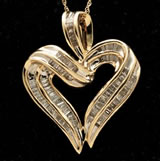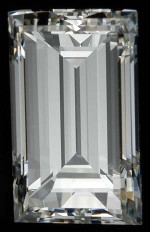 A straight baguette is a relatively small, elongated diamond that usually is rectangular in shape. The word “baguette” is a French word for a long, narrow loaf of bread. This shape, beginning in costume jewelry, grew in demand during the Art Deco and Art Nouveau periods.
A straight baguette is a relatively small, elongated diamond that usually is rectangular in shape. The word “baguette” is a French word for a long, narrow loaf of bread. This shape, beginning in costume jewelry, grew in demand during the Art Deco and Art Nouveau periods.
 The cut is characterized by square corners with rows of step-cut or step-like facets parallel to the table. Baguettes do not conform to the Federal Trade Commission’s “17-facet” requirement for diamonds. The name of the cut must precede the word diamond.
The cut is characterized by square corners with rows of step-cut or step-like facets parallel to the table. Baguettes do not conform to the Federal Trade Commission’s “17-facet” requirement for diamonds. The name of the cut must precede the word diamond.
 The baguette is a step cut style used frequently as side stones. Baguettes have unbeveled corners, usually only two rows of facets, and may be rectangular or tapered. Like the emerald cut, the baguette does not have the sparkle of a brilliant cut but it does have a classic beauty.
The baguette is a step cut style used frequently as side stones. Baguettes have unbeveled corners, usually only two rows of facets, and may be rectangular or tapered. Like the emerald cut, the baguette does not have the sparkle of a brilliant cut but it does have a classic beauty.
 Baguettes can also be lined up to produce a continuous flow of diamonds on a ring, bracelet, brooch or necklace. Baguettes are usually channel-set, but sometimes prong set.
Baguettes can also be lined up to produce a continuous flow of diamonds on a ring, bracelet, brooch or necklace. Baguettes are usually channel-set, but sometimes prong set.
 Baguettes are extraordinarily clear. If baguettes are to be used as side stones or as other matched pairs, they must be similar quality, color and clarity to match each other and the stone they are enhancing. The step-cut appearance is unforgiving and does not allow for little imperfections in the diamonds. A small chip is much more obvious on a baguette than on a more faceted diamond. For that reason, pay particular attention to the quality of stones you might use for side stones.
Baguettes are extraordinarily clear. If baguettes are to be used as side stones or as other matched pairs, they must be similar quality, color and clarity to match each other and the stone they are enhancing. The step-cut appearance is unforgiving and does not allow for little imperfections in the diamonds. A small chip is much more obvious on a baguette than on a more faceted diamond. For that reason, pay particular attention to the quality of stones you might use for side stones.
